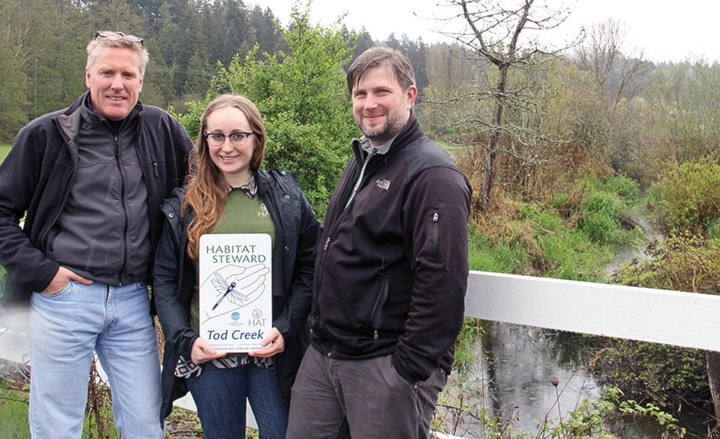Raindrops scribe circles in the slow-moving water off Wallace Drive. Paige Erickson-McGee points to a lush island of tall green grass in the middle of Tod Creek that, to the untrained eye, looks fresh and green and amazing.
It’s killing the ecosystem.
The invasive, non-native reed canarygrass sucks the nutrients from the habitat, explains Erickson-McGee, community and development co-ordinator for Habitat Acquisition Trust.
Native plantings added along the privately owned segment of the creek a few years ago are evident, but not all survived. Adding more and pulling killer grass, will be likely priorities as HAT returns its focus to this segment of the creek, the site of the first Good Neighbours Project in 2001.
“(Through the Good Neighbours Project) we offer events, workshops and home visits to help people learn about their conservation values of their land and find solutions to problems like invasive plants. We teach them how to reduce or eliminate use of artificial fertilizers and pesticides that end up polluting waterways,” says Adam Taylor executive director of HAT.
“This is the first time we’ve come back to a watershed. There’s been a lot of development. The number of new residents (in this area) is dramatic.”
Each year, Good Neighbours focuses on a different area of the Capital Region. The Tod Creek project is one of 13 Vancouver Island projects to receive a portion of nearly $500,000 from Habitat Conservation Trust Foundation.
“HCTF has supported the Good Neighbours program for many years, and have helped to make the program a success,” says Taylor.
The foundation has donated roughly $80,000 to date into various HAT projects, says Brian Springinotic, HCTF chief executive officer.
“Our mandate is to sustain fish and wildlife habitat. HAT has a long history on the ground, and they simply can do things we can not,” says Springinotic.
The strong trust network built with neighbourhoods and residents, in this case sustained since the 2001 project, brings maximum impact to projects, he says.
Tod Creek runs through Saanich to Tod Inlet, meandering through private farms and yards along the way.
“The way these landowners care for their land has a huge impact on the creek … and the integrity of the riparian ecosystem,” Taylor says. “They’re going to impact the way we live, as well as the way wildlife lives.”
Landowners earn a plaque, identifying them as property owners willing to commit to maintaining their land to benefit wildlife.
Another Saanich project receiving funds from the foundation is a project examining the feasibility of enhancing fish habitat in Elk Lake through a water quality improvement program.
Most of the money the foundation uses to fund these projects comes from conservation surcharges on fishing and hunting licences.
“Few people realize how much of the critical conservation work taking place in this province is funded by anglers, hunters, guide outfitters and trappers,” says HCTF chair Harvey Andrusak. “We all benefit. These projects improve conditions for a tremendous range of species, not just those targeted by contributors.”
Learn more about the foundation online at hctf.ca.
reporter@saanichnews.com
••••
Did you know?
Reed canarygrass is invasive and can quickly out-compete other species of native vegetation.
It is particularly threatening to disturbed sites where it can single-handedly transform stream dynamics, preventing the establishment of deep-rooted trees and shrubs.
